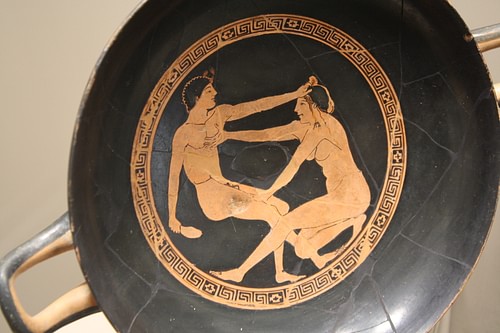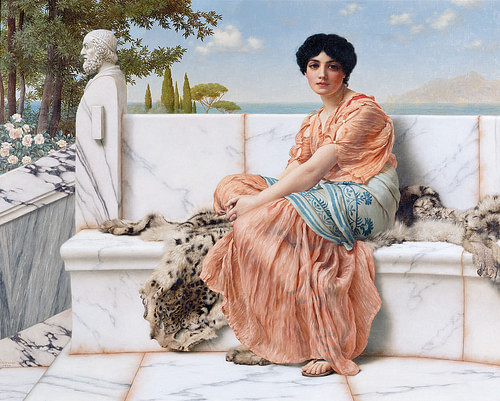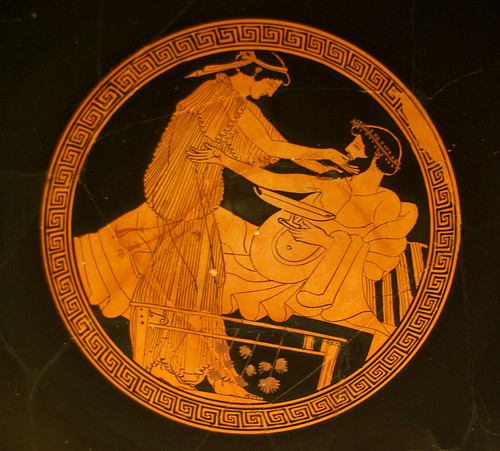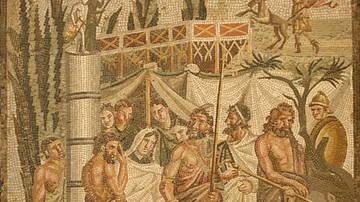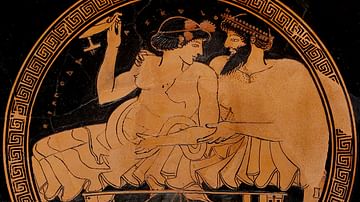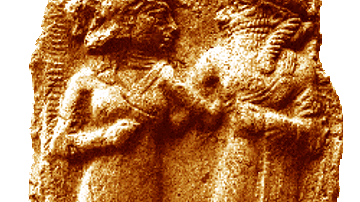Love, sex, and marriage in ancient Greece are portrayed in Greek literature as distinct, yet closely intertwined, elements of life. For many upper-class men, marriages did not take place for love, and other relationships, be it with men or other women, took on this role. Due to this, a lot of the literature discussing love is about the relationships men had outside marriage, often pederastic relationships. For women, marriage was a social and financial decision made by their father and, particularly in classical Athens, women were expected to stay indoors so as to avoid any accusations of infidelity.
Marriage traditions in ancient Greece differed depending on the city-state, and majority of the sources, both literary and material, are about the upper classes. In upper-class families, marriage was seen as a way for the bride’s father to increase the wealth and social standing of the family, and love was rarely a factor. Women would usually get married in their early teens - though this was not the case in Sparta - and men would get married around their mid to late twenties. In Athens, where the majority of the written sources comes from, this was partly because they were expected to complete compulsory military service beforehand. Throughout the ancient Greek world, a fundamental element of the pre-marital arrangements was the dowry, in the form of money, land or anything else of value, arranged by the father of the bride to be given to the groom as part of the marriage agreement.
Marriage in Athens
The most commonly documented form of marriage ceremony in ancient Greek literature is the Athenian tradition. In the Greek tragedy Iphigenia in Aulis, the 5th-century BCE Athenian playwright Euripides describes the wedding preparations (or proaulia) for Iphigenia’s doomed marriage to Achilles:
Gather the baskets for the sacrifices, place wreaths on your head. You, too, Menelaos, get everything ready for this joyous occasion and let’s hear the flutes sing and the dancers pound the earth with their feet. (lines 432-436)
Sacrifices were an important part of the proaulia and so was music that accompanied the procession to the groom’s house on the day of the wedding. The sacrifices were made most commonly to Hera, as she was the divine example of a bride, and to Artemis, the goddess of virginity. The bride would have made sacrifices of animals and food, but, most notably, she would sacrifice her childhood clothes and toys as marriage marked the transition from childhood to adulthood. A 4th-century BCE inscription from Cyrene about purity regulations talks about the premarital sacrifices a woman must make to Artemis as though they are a penalty she must pay for the loss of her virginity.
The wedding day itself (gamos) was primarily focussed on the transference of the bride from her father’s house to her husband’s house. The day began with more sacrifices to the gods to ensure the marriage was blessed and with the bride bathing, a symbol of purity. The bride and groom then made sacrifices together at a temple before going to the home of the bride’s father for a wedding feast. However, the most important parts of the gamos took place in the evening when the groom would drive the bride in a chariot down a torch-lit path to his house, followed by their family and friends who bore gifts and played Greek music. When they arrived at the groom’s home the couple would be showered with dried fruits, a symbol of fertility, before the husband would lead his new wife to the bed chamber where her veil would be ritually removed.
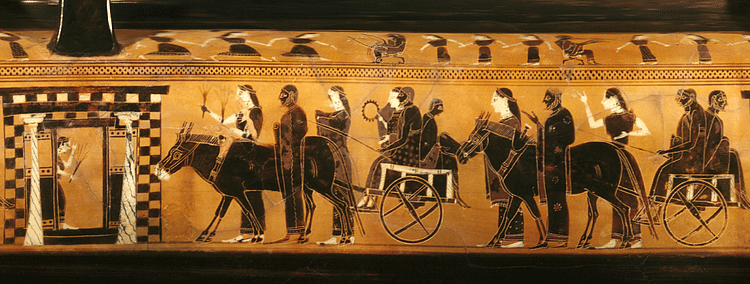
The day after the wedding, relatives and friends would visit the home of the newlyweds to present them with gifts, such as furniture, pots, and jewellery. Many of these were decorated with domestic scenes, particularly depicting the domestic role in the household that the wife was now expected to fulfil. This day was called the epaulia.
Marriage in Sparta
In contrast to the weddings of Athens, Spartan marriage was certainly not a big affair involving family and friends. What traditions did exist were designed to be secretive and took place at night with the wife in disguise. Women were around the age of 18-20 and men were usually in their mid-twenties when they married. According to Plutarch in his Life of Lycurgus, in preparation for the marriage ritual, the bride would "cut her hair off close to the head" and "put a man's cloak and sandals on" (book 15, section 3.) The bride would then be left in a dark room and the groom would ritually capture her. After this, husbands were supposed to visit their new wives in secret and at night.
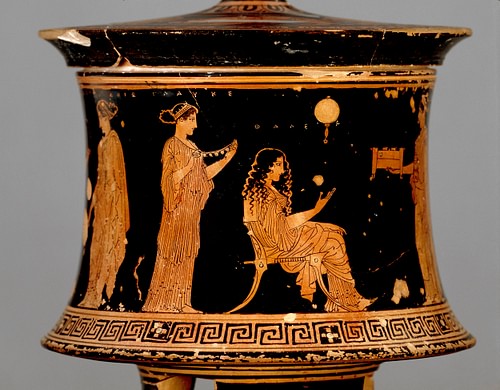
Like the wedding traditions, the life of a Spartan wife after marriage also differed greatly from that of a wife in Athens. In Sparta, men were expected (under threat of being social outcasts) to spend the majority of their time either at war or with their comrades and were not allowed to live with their wives at all until they were 30. Due to this, the wife would have been the head of the household, taking on the responsibility to manage the land and helots (semi-enslaved agricultural labourers) given to the husband by the state. Such freedom and responsibility was not bestowed upon an Athenian wife, whose life was that of confinement. Despite their role in the daily running of the household, primarily raising children and making clothes, they were not by any means the head of the household and were, for the most part, prohibited from leaving the house without an escort. Though, in a rare similarity to Athens, bearing children was seen as the most important role of a woman in Sparta. Many of the laws for women codified by Lycurgus, Sparta’s legendary law-giver, were made to ensure that women would produce healthy children. One of these laws was making women participate in physical exercise to make them stronger for childbirth.
Family Life
In ancient Greece, having a family and raising children, particularly male, citizen heirs, was paramount. The 4th-century BCE Athenian statesman Demosthenes described a wife’s role in the family very bluntly in a statement saying that their job was to "bear us legitimate children and to be faithful guardians of our households" (Against Neaera, 59, 122.) It was seen as a wife’s duty to serve her husband and to ensure the upkeep of his property and the continuation of his line. In an Athenian family, the father was the head of the household (kyrios) who was legally responsible for and in control of his wife, children and unmarried female relatives. For these women, he would be responsible for arranging marriages and providing dowries. He even had the power to reject any child at birth that he did not wish to keep.
An Athenian wife was confined to her own part of the household, the Gynaeceum, where she would bring up her sons until the age of seven and teach her daughters how to make clothes, weave, cook, organise food, and manage slaves. Learning these skills was the upshot of an Athenian girl’s education, unlike her brother who would have engaged in formal education from the age of seven. This education was overseen by a pedagog, a slave who would take the son to school every day and keep the child's father informed on his progress. The son would have learnt arithmetic, music, writing and reading, primarily Homer’s Iliad and Odyssey, which he would have been expected to memorise. This education usually ended at the age of 15, though those who did not have to work could join a gymnasium where they would further their studies in topics like science and Greek philosophy.

Divorce
In ancient Greece, the process of initiating divorce was a lot simpler for men than for women. In Athens, all the husband had to do was send his wife back to her father’s house and pay back her dowry. When a wife was found to have committed adultery, the husband was expected to divorce her to avoid legitimacy issues of a child born. For a woman, divorce was more complicated. Firstly, she needed to present her request in front of an archon (one of the chief city magistrates) then have the support of her father or closest male relative. The wife’s father also had the ability to force a divorce, (even if neither the husband nor the wife wanted it), if the marriage proved infertile. According to Herodotus in Book Six of The Histories, the same principle was followed in Sparta; infertility was grounds for a divorce.
Love in Ancient Greece
Throughout ancient Greece, romantic love was written about extensively in philosophy and poetry. So much so, that even the belief in soulmates that many people hold today was first being kindled in Plato’s Symposium. Love of this nature is not often talked about as existing within a marriage, and a lot of the discussion of romantic love in ancient Greece concentrates on its existence in the extramarital homosexual relationships that men had. Though, if the couple was lucky, love may have existed in marriage, even if it was not the reason for it. An example of love within a marriage being depicted in art can be interpreted from Philomelos and Plathane’s grave stele, which was found in the Kerimeikos and can be dated to the 5th century BCE. The relief on the grave marker shows the couple joining hands, a symbol of the lasting unity between the dead and their loved ones.
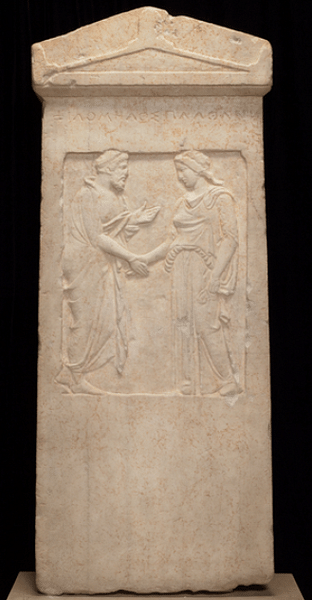
When discussing love in ancient Greece, a name that often comes up is Sappho (630- 570 BCE), the Greek lyric poet from the island of Lesbos whose writing on the women she loved and the heartbreak that ensued if her feelings were not reciprocated has made her one of the most famous names in ancient Greek literature. In an androcentric world, Sappho writes from a woman’s perspective on her love for other women, showing how much social constructs on what love was varied. Throughout her poetry, Sappho describes love to be both beautiful and painful depending on the state of the relationship. In fragment 94, for example, she is bidding her lover farewell when neither of them wants to leave the other:
Frankly I wish that I were dead:
She was weeping as she took her leave from me
And many times she told me this:
'Oh what sadness we have suffered,
Sappho, for I’m leaving you against my will.'
So I gave this answer to her:
'Go be happy but remember me there, for you know how we have cherished you,
If not, then I would remind you
[of the joy we have known,] of all
The loveliness that we have shared together;
For many wreaths of violets
Of roses of crocuses
… you wove around yourself by my side
… and many twisted garlands
which you had woven from the blooms
Of flowers, you placed around your slender neck
… and you were anointed with
A perfume, scented with blossom
… although it were fit for a queen
And on a bed, soft and tender
… you satisfied your desire…'
The desperate pain Sappho portrays in the first stanza and the conflicting emotion of wishing the one that hurt you well are very recognisable and timeless emotions. Sappho tells us that, even early on in the timeline of ancient Greek literature, an awareness existed of the intense and sometimes conflicting feelings that love causes. This is also famously shown in fragment 130 where she hails love as "bittersweet, undefeated creature - against you there is no defence." This poem marks the first known use of the word 'bittersweet' (γλυκύπικρον) in literature.
In his Symposium, Plato also speaks of love as an overwhelming force that brings two people together. Plato mainly focusses on the pederastic relationships of classical Athens - relationships that existed between an adult male (the erastes) and a teenage boy (the eromenos). These relationships were a social norm amongst the upper class, and the role of the relationship was normally justified as educative, though a sexual element was certainly involved. Perhaps the most striking speech from Plato's Symposium is Aristophanes’; it presents the idea of an innate force driving us to find our other half. Plato’s Aristophanes even goes so far as to discuss what the reaction to two people in love being physically melted and welded together would be. The story is a peculiar one, perhaps even written to be comedic, (as Aristophanes was a comic playwright), but its allusion to the idea of soulmates and having an ‘other half’ that is still very present in our society today.
Firstly, Aristophanes explains that a long time ago there were three sexes - male, female and androgynous - they were all round in shape with two sets of limbs and two faces. These early humans were powerful and they tried to attack the gods and so Zeus proposed reducing their strength by cutting them in half. Apollo healed the injury by closing it at the navel, but humans were now left with an even bigger wound and that was the loss of their other half. Each half now longed for the other. Zeus pitied them and invented sex as a solution. In this way, Plato also introduces the importance of sex in relationships and how this desire relates to love.
Sex in Ancient Greece
In ancient Greece, attitudes and views on sexuality differed greatly depending on gender. The sexuality of a woman was generally surrounded by stigma and suspicion, particularly in classical Athens, as their primary role in society was to produce legitimate children. The sexuality of a man, on the other hand, was treated very liberally. In Demosthenes’ Against Neaera, he states that "Mistresses we keep for the sake of pleasure, concubines for the daily care of our persons, but wives to bear us legitimate children and to be faithful guardians of our households" (59, 122).
For men, it was socially acceptable to partake in sexual relationships outside of their marriage. Men could both hire prostitutes and have concubines without being viewed as unfaithful. For instance, at symposia - a popular sort of party consisting of a banquet and entertainment - hetairai would often be employed. Unlike pornai (prostitutes who usually worked in brothels), a hetaira was a well-educated woman who could be hired by men, not only for sex but also for their skills in Greek dance, music, and conversation. Some men also chose to have pallakae (concubines), often slaves who the men would buy and take into their households.
Men could also partake in pederastic relationships. The ancient Greeks did not view sexuality or love in terms of gender as much as they viewed them in terms of power dynamics. Thus, the only aspect of a relationship that would bring about shame was being the passive partner in a relationship with another man. Pederastic relationships were usually approved by the eromenos’ father as these relationships were believed to play an important role in the education and initiation of an upper-class male into society.
Though extramarital affairs were normal for the men of ancient Greece, when it came to women, they were strictly condemned. The stress put on a woman’s fidelity in ancient Greece made her sexuality a topic that was talked about little and, due to this same reason, the ideal woman generally seems to be the one who lived her life in obscurity. Throughout classical literature, the fidelity that Penelope from Homer’s Odyssey presents is looked upon as being the hallmark of the ideal Greek woman. As she waited 20 years for Odysseus to return from the Trojan War, she turned away hundreds of suitors who were vying for her hand. The loyalty Penelope shows towards her husband in doing this and the lack of interest in other men is celebrated in the final book of the Odyssey. The ghost of Agamemnon speaks about her virtue’s fame as being immortal, and, from what we know of the attitudes towards a woman’s sexuality in classical Athens, we certainly see this ideal in place centuries down the line.
